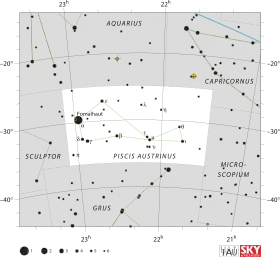 | |
| Observation data Epoch J2000.0 Equinox J2000.0 (ICRS) | |
|---|---|
| Constellation | Piscis Austrinus |
| Right ascension | 22h 52m 31.52285s[1] |
| Declination | −32° 52′ 31.7041″[1] |
| Apparent magnitude (V) | +4.448[2] (4.59 + 8.20)[3] |
| Characteristics | |
| γ PsA A | |
| Spectral type | A0 Vp(SrCrEu)[4] |
| U−B color index | −0.038[2] |
| B−V color index | −0.046[2] |
| γ PsA B | |
| Spectral type | F5 V[5] |
| U−B color index | −0.08[5] |
| B−V color index | +0.44[5] |
| Astrometry | |
| Radial velocity (Rv) | 16.5±2.7[6] km/s |
| Proper motion (μ) | RA: −25.039[1] mas/yr Dec.: −30.933[1] mas/yr |
| Parallax (π) | 16.0365 ± 0.4505 mas[1] |
| Distance | 203 ± 6 ly (62 ± 2 pc) |
| Absolute magnitude (MV) | −0.20/3.50[5] |
| Details[7] | |
| γ PsA A | |
| Mass | 2.63 M☉ |
| Surface gravity (log g) | 3.92 cgs |
| Temperature | 10,776±366 K |
| Rotational velocity (v sin i) | 47 km/s |
| Age | 214 Myr |
| Other designations | |
| Database references | |
| SIMBAD | γ PsA |
| γ PsA A | |
| γ PsA B | |
Gamma Piscis Austrini, Latinized from γ Piscis Austrini, is binary star[3] system in the southern constellation of Piscis Austrinus. It is visible to the naked eye with a combined apparent visual magnitude of +4.448.[2] As of 2010, the pair had an angular separation of 4 arc seconds along a position angle of 255°.[9] Based upon an annual parallax shift of 16.0 mas as seen from the Earth,[1] the system is located about 203 light years from the Sun.
The magnitude 4.59[3] primary, component A, is a white-hued, chemically peculiar A-type main sequence star with a stellar classification of A0 Vp(SrCrEu).[4] It is an estimated 214 million years old with 2.63 times the mass of the Sun. The fainter magnitude 8.20[3] companion, component B, is an F-type main sequence star with a class of F5 V.[5]
Gamma Piscis Austrini is moving through the Galaxy at a speed of 24.1 km/s relative to the Sun. Its projected Galactic orbit carries it between 21,605 and 30,903 light-years from the center of the Galaxy. It came closest to the Sun 1.8 million years ago at a distance of 157 light-years.[10]
Naming
In Chinese, 敗臼 (Bài Jiù), meaning Decayed Mortar, refers to an asterism consisting of refers to an asterism consisting of γ Piscis Austrini, γ Gruis, λ Gruis and 19 Piscis Austrini. Consequently, the Chinese name for γ Piscis Austrini itself is 敗臼三 (Bài Jiù sān, English: the Third Star of Decayed Mortar.)[11]
References
- 1 2 3 4 5 6 Brown, A. G. A.; et al. (Gaia collaboration) (August 2018). "Gaia Data Release 2: Summary of the contents and survey properties". Astronomy & Astrophysics. 616. A1. arXiv:1804.09365. Bibcode:2018A&A...616A...1G. doi:10.1051/0004-6361/201833051. Gaia DR2 record for this source at VizieR.
- 1 2 3 4 Rakos, K. D.; et al. (February 1982), "Photometric and astrometric observations of close visual binaries", Astronomy and Astrophysics Supplement Series, 47: 221–235, Bibcode:1982A&AS...47..221R.
- 1 2 3 4 Eggleton, P. P.; Tokovinin, A. A. (September 2008), "A catalogue of multiplicity among bright stellar systems", Monthly Notices of the Royal Astronomical Society, 389 (2): 869–879, arXiv:0806.2878, Bibcode:2008MNRAS.389..869E, doi:10.1111/j.1365-2966.2008.13596.x, S2CID 14878976.
- 1 2 Abt, Helmut A.; Morrell, Nidia I. (July 1995), "The Relation between Rotational Velocities and Spectral Peculiarities among A-Type Stars", Astrophysical Journal Supplement, 99: 135, Bibcode:1995ApJS...99..135A, doi:10.1086/192182.
- 1 2 3 4 5 Corbally, C. J. (1984), "Close visual binaries. I - MK classifications", Astrophysical Journal Supplement Series, 55: 657, Bibcode:1984ApJS...55..657C, doi:10.1086/190973.
- ↑ Gontcharov, G. A. (2006), "Pulkovo Compilation of Radial Velocities for 35 495 Hipparcos stars in a common system", Astronomy Letters, 32 (11): 759–771, arXiv:1606.08053, Bibcode:2006AstL...32..759G, doi:10.1134/S1063773706110065, S2CID 119231169.
- ↑ David, Trevor J.; Hillenbrand, Lynne A. (2015), "The Ages of Early-Type Stars: Strömgren Photometric Methods Calibrated, Validated, Tested, and Applied to Hosts and Prospective Hosts of Directly Imaged Exoplanets", The Astrophysical Journal, 804 (2): 146, arXiv:1501.03154, Bibcode:2015ApJ...804..146D, doi:10.1088/0004-637X/804/2/146, S2CID 33401607.
- ↑ "gam PsA -- Double or multiple star", SIMBAD Astronomical Database, Centre de Données astronomiques de Strasbourg, retrieved 2017-05-18.
- ↑ Mason, B. D.; et al. (2014), "The Washington Visual Double Star Catalog", The Astronomical Journal, 122 (6): 3466, Bibcode:2001AJ....122.3466M, doi:10.1086/323920.
- ↑ Anderson, E.; Francis, Ch. (2012), "XHIP: An extended hipparcos compilation", Astronomy Letters, 38 (5): 331, arXiv:1108.4971, Bibcode:2012AstL...38..331A, doi:10.1134/S1063773712050015, S2CID 119257644.
- ↑ (in Chinese) AEEA (Activities of Exhibition and Education in Astronomy) 天文教育資訊網 2006 年 7 月 5 日
External links
- Kaler, James B. (October 29, 2010), "Gamma Piscis Austrini", Stars, University of Illinois.